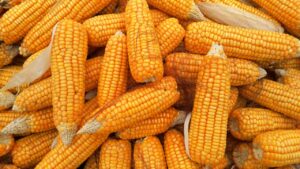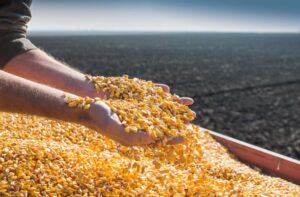
The harvest of corn, according to preliminary estimates of the Ministry of Agrarian Policy and Food, in 2024 will be 25 million tons, sunflower – 12 million tons, soybeans – 5 million tons, said Minister of Agrarian Policy and Food Vitaly Koval in an interview with Forbes Ukraina.
“Ukraine did not receive about 2% of early grains compared to last year’s harvest. This group did not suffer as much as late crops. Soybeans, buckwheat, corn and sunflower suffered the most. They have a shortfall of about 10-15% depending on the region. However, this is not critical for the food security of the country,” he said.
Koval expressed confidence that in the new season the structure of crops will not change globally compared to last year. At the same time, the Ministry of Agrarian Policy has concerns about winter rape: there is not enough moisture to sow it.
“In total, about 5 million hectares of winter crops will be sown,” summarized the Minister of Agrarian Policy.

In its August report, the U.S. Department of Agriculture (USDA) slightly lowered its forecast for the corn crop in Ukraine. The decrease compared to July is 1.8%, namely to 27.2 million tons (-0.5 million tons), exports – 24 million tons (-0.5 million tons), ending stocks increased to 0.73 million tons (+0.5 million tons).
World corn production is reduced to 1.219 billion tons (-0.005 billion tons), exports – to 191.47 million tons (-0.34 million tons), carry-over stocks – 310.17 million tons (-1.47 million tons).
Analysts have lowered their estimates of global corn production due to extreme heat and drought in southeastern Europe and the Southern and North Caucasus regions of Russia in July, which affected crop yields. Corn production in Ukraine was reduced, as the expansion of corn production areas was offset by lower yield expectations.

In the second quarter of 2024, Astarta Agro Holding sold 141.9 thousand tons of sugar, up 106% year-on-year, and increased sugar sales by 77% to 211.4 thousand tons over two quarters.
According to the company’s announcement on the Warsaw Stock Exchange, the average sugar price in the second quarter decreased by 13% compared to the same period last year and by 10% over six months.
Astarta’s corn sales in the second quarter increased by 109% to 123 thousand tons, up from 58.8 thousand tons a year earlier. In the first half of the year, corn sales increased by 18% to 337.9 thsd tonnes.
At the same time, sales of sunflower seeds decreased by 98% to 705 thsd tonnes, while their selling price increased by 20%. In the first half of the year, sunflower sales decreased by 67% to 20.066 thsd tonnes, while prices were 20% lower than last year.
Sales of soybean oil in the second quarter decreased by 24% to 44.788 thousand tons, while prices also fell by 10%. Sales in the first half of 2024 increased by 21% year-on-year to 27.142 thousand tons, but prices were 15% lower.
In addition, in the second quarter, Astarta reduced sales of soybean flour by 24% to 44,788 thousand tons, while prices were 10% lower than last year. In the first half of 2024, they were 10% lower compared to the same period last year.
The agricultural holding’s sales of milk in the second quarter increased by 4% to 29.42 thousand tons, while the price of the product increased by 20%. Sales in the first half of 2024 increased by 5% to 60,013 thousand tons, prices – by 21%.
In 2023, Astarta, the largest sugar producer in Ukraine, reduced its net profit by 5.0% to EUR 61.9 million, and its EBITDA decreased by 6.1% to EUR 145.77 million, while revenue increased by 21.3% to EUR 618.93 million.
Astarta CEO Viktor Ivanchik’s family currently owns 40.68% of the company. Fairfax Financial Holdings is also a major shareholder with 29.91%, and another 2.12% of shares belong to the company itself and were previously bought back as part of a buyback.
According to the National Bank of Ukraine, as of October 1, 2023, Credit Agricole Bank ranked 11th in terms of total assets (UAH 100.36 billion) among 63 operating banks in the country, with 141 branches. The bank is fully owned by French Credit Agricole SA.

Ukraine is exhausting its tariff-free quotas for honey, corn and chicken supplies to the European Union, European Commissioner for Agriculture Janusz Wojciechowski said at a conference after the Council of Agricultural Ministers meeting in Brussels on Monday.
“I am pleased that today, during the discussion on Ukraine, member states generally expressed positive views on the new autonomous trade measures and on the safeguard measures introduced. It was the initiative of the European Commissioner for Agriculture to introduce these import limits, and they are working. They were activated for three products – sugar, eggs and oats. We are observing the situation with other sensitive products. Honey, whose exports have already reached 89% of the limits, corn – 67%, and chicken – 59%,” he said.
Wojciechowski emphasized that European politicians’ accusations against the EU’s Common Agricultural Policy that it is aimed at reducing domestic production and further increasing dependence on imported products are unfounded. The EU has been and will remain the largest exporter of agricultural products in the world, he assured.
According to the European Commissioner, the EU’s agricultural trade surplus in 2023 reached a record EUR 70 billion. This year, this record may be broken, as in the first quarter alone, the EU’s trade surplus with third countries already amounted to EUR 18 billion.

The heatwave in Ukraine will not have a major impact on the harvest of early crops, but we can no longer count on high yields of late oilseeds, including corn and soybeans, said Taras Vysotsky, acting Minister of Agrarian Policy and Food, during the Unified National Telethon.
He reminded that there are two types of crops grown in Ukraine – early and late. The harvest of early crops is already underway. We are talking about wheat and barley, as well as oats, peas, rye, and rapeseed.
“These crops are also subject to the heat effect, but it is not critical. They are even favorable for harvesting,” the acting minister said.
According to him, the average yield of early grain crops is 37 centners per hectare. However, it will grow as the harvest continues in the southern and central regions. In particular, Odesa, Mykolaiv, Kirovohrad, and Dnipro regions have already harvested more than 1 million tons each. Next, the western and northern regions will start harvesting, where yields will be higher.
As of today, the average yield of early crops is expected to be around 45-48 cwt/ha, Vysotsky emphasized.
“If we look at the later crops, which are primarily corn, sunflower and soybeans, there may be a negative effect of the heat, as it is the peak of flowering, pollination and growth of these crops. It all depends on the weather in the coming weeks. But as of today (it can be stated – IF-U), the current heat will not allow us to collect record figures for corn and sunflower,” said the acting Minister.
Vysotsky said that the production of early grains is expected to reach 27 million tons. The domestic consumption of this group of crops is about 6-8-9 million tons, which is three times higher than the domestic demand. Therefore, there will be no grain shortage in the country, and no sharp price fluctuations are expected.
At the same time, he said, the situation may change in the fall. In August, after the early grain harvest is completed, the situation with other crops will become clear.
“As of today, the price change is expected to be more at the level of inflation or devaluation, because these (crops – IF-U) are export-oriented goods. They are also tied to the hryvnia exchange rate. No sharp price changes are expected based on this levy (of early grain crops – IF-U),” the acting minister stated. He added: “The final forecast for the crop harvest will be made in the second half of August.”

As of June 22, Ukraine exported 2.2 million tons of corn, indicating a high level of activity in the market, according to the analytical cooperative “Start”, created within the framework of the All-Ukrainian Agrarian Council (AAC).
Analysts predict that June will be the most productive month for exports, but in July-August, the figures may decline significantly as the market switches to a new harvest.
“The global situation was unfavorable for Ukrainian corn. Although it is still in demand on the Italian market, its competitiveness is decreasing due to the pricing policy. For example, Argentine corn is sold at $212-213/ton on the Italian market, which is about the same level as Ukrainian corn. At the same time, Argentine corn is several dollars cheaper in Spain, making it more attractive to buyers. Under such conditions, Ukrainian traders are not in a hurry to sell their existing stocks, as their volume is limited,” the experts said.
According to their information, the corn market is entering the off-season, and prices are expected to stabilize in the coming weeks.
“If there is demand, the conditional prices for corn may fluctuate within $172-174 per ton. On average, on the CPT basis, the price will be around $170/ton in the coming weeks,” Pusk summarized.